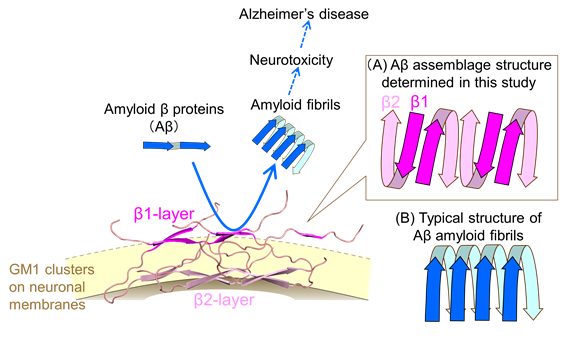Unraveling Alzheimer's Catalysts as Weavers of Amyloid β Fibrils
Summary Text
Researchers from the National Institutes of Natural Sciences and Nagoya City University have achieved a significant breakthrough by elucidating the structure of amyloid β (Aβ) bound to glycolipids on the surface of nerve cells. This finding shed light on the critical role of abnormal Aβ fibril formation, a major contributor to Alzheimer's disease, and holds promise for innovative advancements in medicine and pharmacy.
Full Text
Researchers from the National Institutes of Natural Sciences and Nagoya City University have achieved a significant breakthrough by elucidating the structure of amyloid β (Aβ) bound to glycolipids on the surface of nerve cells. This finding shed light on the critical role of abnormal Aβ fibril formation, a major contributor to Alzheimer's disease, and holds promise for innovative advancements in medicine and pharmacy.
Alzheimer's disease is characterized by the abnormal aggregation of Aβ into amyloid fibrils, which accumulate in the brain. Understanding the molecular mechanism of Aβ fibril formation is crucial in the fields of medicine and pharmacy. To address this, researchers focused on the interaction of Aβ with glycolipids called GM1 gangliosides on the neuronal cell membrane.
Using solid-state nuclear magnetic resonance spectroscopy and molecular dynamics simulations, the research group revealed that Aβ adopts a "U"-shaped conformation upon binding with GM1 gangliosides on the membrane surface. This "U"-shaped Aβ structure consists of two layers, the β1 layer (distal from the membrane) and the β2 layer (closer to the membrane), arranged alternately (see figure). In contrast to previously reported Aβ amyloid fibrils, which align in a uniform direction, the Aβ assembly on membranes containing GM1 gangliosides exhibited a completely different conformation. Notably, the highly exposed β1 layer on the membrane surface was found to act as a catalyst, significantly accelerating the fibrillation of surrounding Aβ molecules. Furthermore, the anti-GM1-Aβ antibodies were specifically observed to recognize this region.
This research successfully unveiled the three-dimensional structure of Aβ, acting as a catalytic platform for amyloid fibril formation, in the presence of GM1 gangliosides on neuronal cell membranes. While various therapeutic antibodies targeting Aβ aggregates have been developed, they primarily bind to amyloid fibrils or their precursors. The distinct Aβ structure discovered in this study offers novel possibilities as the anti-GM1-Aβ antibodies are capable of recognizing and binding to this unique conformation. Consequently, this research represents the first identification of the structural entity responsible for producing amyloid fibrils in brain tissue, potentially offering insights into predicting the onset risk of Alzheimer's disease and opening avenues for inhibiting its progression. The three-dimensional structure of Aβ molecules, as revealed in this study, provides exciting prospects for developing new therapeutic strategies against Alzheimer's disease.
Researchers from the National Institutes of Natural Sciences and Nagoya City University have achieved a significant breakthrough by elucidating the structure of amyloid β (Aβ) bound to glycolipids on the surface of nerve cells. This finding shed light on the critical role of abnormal Aβ fibril formation, a major contributor to Alzheimer's disease, and holds promise for innovative advancements in medicine and pharmacy.
Full Text
Researchers from the National Institutes of Natural Sciences and Nagoya City University have achieved a significant breakthrough by elucidating the structure of amyloid β (Aβ) bound to glycolipids on the surface of nerve cells. This finding shed light on the critical role of abnormal Aβ fibril formation, a major contributor to Alzheimer's disease, and holds promise for innovative advancements in medicine and pharmacy.
Alzheimer's disease is characterized by the abnormal aggregation of Aβ into amyloid fibrils, which accumulate in the brain. Understanding the molecular mechanism of Aβ fibril formation is crucial in the fields of medicine and pharmacy. To address this, researchers focused on the interaction of Aβ with glycolipids called GM1 gangliosides on the neuronal cell membrane.
Using solid-state nuclear magnetic resonance spectroscopy and molecular dynamics simulations, the research group revealed that Aβ adopts a "U"-shaped conformation upon binding with GM1 gangliosides on the membrane surface. This "U"-shaped Aβ structure consists of two layers, the β1 layer (distal from the membrane) and the β2 layer (closer to the membrane), arranged alternately (see figure). In contrast to previously reported Aβ amyloid fibrils, which align in a uniform direction, the Aβ assembly on membranes containing GM1 gangliosides exhibited a completely different conformation. Notably, the highly exposed β1 layer on the membrane surface was found to act as a catalyst, significantly accelerating the fibrillation of surrounding Aβ molecules. Furthermore, the anti-GM1-Aβ antibodies were specifically observed to recognize this region.
This research successfully unveiled the three-dimensional structure of Aβ, acting as a catalytic platform for amyloid fibril formation, in the presence of GM1 gangliosides on neuronal cell membranes. While various therapeutic antibodies targeting Aβ aggregates have been developed, they primarily bind to amyloid fibrils or their precursors. The distinct Aβ structure discovered in this study offers novel possibilities as the anti-GM1-Aβ antibodies are capable of recognizing and binding to this unique conformation. Consequently, this research represents the first identification of the structural entity responsible for producing amyloid fibrils in brain tissue, potentially offering insights into predicting the onset risk of Alzheimer's disease and opening avenues for inhibiting its progression. The three-dimensional structure of Aβ molecules, as revealed in this study, provides exciting prospects for developing new therapeutic strategies against Alzheimer's disease.

Figure: (A) On the neuronal cell membrane, Aβ molecules adopt a "U"-shaped conformation, allining alternately on the membrane surface to form two layers: the β1 layer, distal from the membrane, and the β2 layer, closer to the membrane. This assembly of Aβ acts as a "catalytic platform," accelerating the fibrillation of surrounding Aβ molecules. (B) In previously reported Aβ amyloid fibrils, Aβ molecules align in the same direction.


